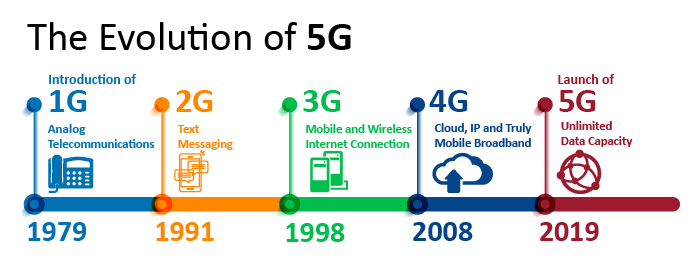Rodger Tucker
Student Author Spring 2021

For several years, the cellular network has benefited student’s daily lives. The evolution to 5G continues to be a demand and play a critical role in better user experiences.
The cellular network has become an alternative way to stay connected on the go for many years. Now with 5G, we can stay connected much faster with virtually no latency.
What is latency?
Latency is the time that passes between a user’s action and the resulting response. We have all experienced this. We click on something on a webpage or application, hoping it will execute but it just sits there without a change. Another example is if you are watching a video online and it constantly skips or lags. Online classes have nearly tripled recently due to COVID-19 safety measures. Can you imagine missing what your professor said in an online meeting due to a bad connection? Or if you are working online at home and you cannot clock in or out because of a bad connection?
It is a fact that having a fast and reliable internet connection increases student productivity and a smoother course completion. It has also been proven that businesses and other fields have shown an increase in work completion and user satisfaction.
As we talked about in my previous article, 5G can provide another strong source for Wi-Fi across campuses. But not only can campuses improve, but densely populated cities like Orlando will also too.
COVID-19 has caused numerous shutdowns world-wide. It has made people work from home and students taking more online classes. This has caused a huge demand for faster speeds, an uncluttered network access, and less latency. Billions of dollars were spent for this demand, and roughly $800 million was from the student population.
What’s Next?
Theres 5g and now 5g ultra-wideband. As we have seen with past cellular spectrums, there will be more adaptions to come.
5G only just recently entered the commercial world, and — especially with the higher millimeter-wave (mmWave) frequencies — it has a long way to go before it reaches its full potential. Even so, some researchers and industry members are looking beyond 5G to figure out what comes next.
NTT Docomo’s Takehiro Nakamura took a stab at both how 5G would be extended through an “evolution” phase and what would happen with 6G beyond that. He sees both 5G evolution (5GE) and 6G continuing the trend towards increased bandwidth, increased coverage, and increased volumes of data. [Note: In the US, some companies are calling extensions of 4G prior to 5G “5GE,” causing possible confusion. NTT Docomo’s references to 5GE follow the more traditional meaning of coming after 5G.]
Nakamura started by reminding us that 5G went live just this last March and that it will be the dominant technology through the 2020s. He said that 6G is a technology for the 2030s, although dates and definitions will likely vary, depending upon the vendor.
Conclusion
All user groups, especially students have been benefited from the cellular network. Having the ability to go online to do schoolwork, to run your business, or to simply stay entertained without latency is a top concern. We will continue see the evolution of 5G and more to come in the future. We live in a world that operates with the internet. Just like roadways I believe we will see lots of changes over time to meet demand.
ABOUT THE AUTHOR
Rodger Tucker
Student Author - Spring 2021









